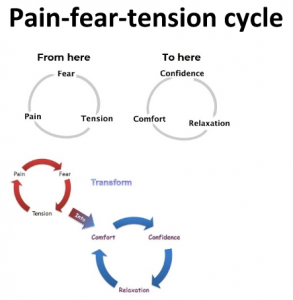Understand & Transform
 Most women ruminate about labor pain in childbirth; rarely it is not mentioned as one of the main challenges.
Most women ruminate about labor pain in childbirth; rarely it is not mentioned as one of the main challenges.
In general pain is associated with injuries or as a signal that something is wrong in our body needing attention to be healed. But labor pain is functional discomfort: strong contractions/surges are
needed to dilate the cervix and pressure on internal organs and the rectum signal the descent of the baby. The attention labor needs is to find a safe birth place and the cure for all the challenge is the birth of your baby.
With safety comes relaxation and a feeling of trust. It comes along with deep rhythmic breathing and reduced pain sensations easing the birthing process. Fear comes with tension, rapid short breaths, increased adrenaline and pulse acceleration all coupled with a fight flight response or a freeze, a ‘playing dead’; in the birth process we often see it as a ‘stalled labor’.
Fear is the only instinct that has the power to immobilize (Liz Koch, 2012: The Psoas Book).
Grantley Dick-Read, the famous British Obstetrician and pioneer in childbirth education through the 1950’s and 1960’s claimed that if women were relaxed during labor they would experience little or no pain. He devised the pain-fear-tension cycle as a way of explaining how our emotional responses can increase the sensation and intensity of pain.
How to avoid or find your way out of this fear-tension-cycle is the great question.
I’m all listening – happy to explore with you options!
Pain-Fear-Tension Cycle
Understand & Transform
Most women ruminate about labor pain in childbirth; rarely it is not
mentioned as one of the main challenges.
In general pain is associated with injuries or as a signal that something is wrong in our body needing attention to be healed.
But labor pain is functional discomfort: strong contractions/surges are
needed to dilate the cervix and pressure on internal organs and the rectum signal
the descent of the baby. The attention labor needs is to find a safe birth place and
the cure for all the challenge is the birth of your baby.
With safety comes relaxation and a feeling of trust. It comes along with deep rhythmic breathing and reduced pain sensations easing the birthing process. Fear comes with tension, rapid short breaths, increased adrenaline and
pulse acceleration all coupled with a fight flight response or a freeze, a ‘playing
dead’; in the birth process we often see it as a ‘stalled labor’.
Fear is the only instinct that has the power to immobilize (Liz Koch, 2012: The Psoas Book).
Grantley Dick-Read, the famous British Obstetrician and pioneer in childbirth education through the 1950’s and 1960’s claimed that if women were relaxed
during labor they would experience little or no pain. He devised the pain-fear-
tension cycle as a way of explaining how our emotional responses can increase
the sensation and intensity of pain.
How to avoid or find your way out of this fear-tension-cycle is the great question.
I’m all listening – happy to explore with you options!
 Most women ruminate about labor pain in childbirth; rarely it is not mentioned as one of the main challenges.
Most women ruminate about labor pain in childbirth; rarely it is not mentioned as one of the main challenges.